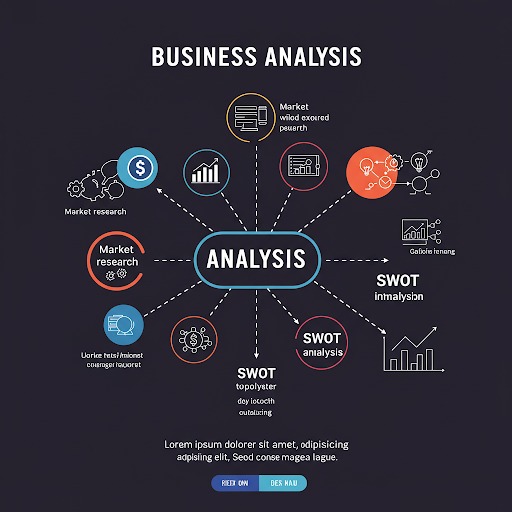Business Analysis
Business Analysis is a critical discipline that focuses on identifying business needs, problems, opportunities, and solutions to improve processes, products, or services. It is an essential part of project management, IT initiatives, organizational change, and strategic planning. Business analysts (BAs) play a vital role in helping organizations understand their operations, set priorities, and find the most efficient ways to solve business problems and achieve objectives.

Why Choose Our Cloud Solutions?
We modernize infrastructure, streamline outdated processes, and optimize cloud assets to build future-ready ecosystems.
Technology We Use

AWS

IBM Cloud

Google Cloud

Microsoft Azure
Definition of Business Analysis
Business Analysis is the practice of identifying business needs, analyzing processes, and finding solutions to improve performance. It involves understanding an organization’s goals and objectives, assessing existing operations, identifying inefficiencies or problems, and recommending strategies to address those challenges. It’s also about ensuring that the solutions implemented align with the overall strategy and deliver value.
Requirement Gathering and Analysis
Understanding and documenting the needs of stakeholders, clients, or end-users. This could involve interviews, surveys, workshops, or reviewing business documents.
Business Process Modeling
Analyzing and documenting current business processes (as-is) and designing improved processes (to-be) to achieve operational efficiencies.
Feasibility Studies
Assessing the viability of solutions, including cost-benefit analysis, risk assessment, and resource requirements.
Stakeholder Communication
Acting as a liaison between business stakeholders (e.g., management, marketing, operations) and technical teams (e.g., IT, development) to ensure alignment and clear understanding of requirements.
Solution Design and Validation
Helping design solutions or recommending improvements, whether in technology, processes, or organizational structures, to address business needs.
Change Management Support
Assisting in the management of organizational change, ensuring smooth implementation and adoption of new processes or technologies.
Core Skills Required for Business Analysis
Analytical Thinking
The ability to break down complex problems, identify root causes, and assess the impact of different solutions.
Requirements Elicitation
Proficiency in gathering detailed business requirements through methods like interviews, workshops, and document analysis.
Communication Skills
The ability to communicate complex ideas clearly and concisely to both business stakeholders and technical teams.
Problem-Solving
Identifying issues and proposing viable solutions that meet business objectives.
Process Modeling
Creating visual models of business processes (e.g., flowcharts) to better understand and optimize workflows.
Technical Knowledge
Understanding of IT systems and tools to communicate effectively with technical teams.
Business Analysis Process
Initiation/Planning
Defining the scope of the analysis and identifying stakeholders. Creating a business analysis plan to outline the approach, resources, and timeline.
Elicitation
Gathering requirements from stakeholders through techniques like interviews, workshops, focus groups, surveys, and document analysis.
Analysis
Creating use cases, user stories, and business process models. o Prioritizing requirements based on business value and feasibility
Solution Design
Proposing changes to business processes, systems, or technology to achieve improvements.
Implementation
Supporting the development and deployment of the solution. Ensuring that requirements are met, and the solution is tested and validated.
Evaluation
Measuring the effectiveness of the solution in solving the business problem or achieving the business goal.
Techniques and Tools Used in Business Analysis
SWOT Analysis
A strategic planning tool to evaluate an organization’s strengths, weaknesses, opportunities, and threats.
Business Process Modeling
Tools like flowcharts, Business Process Model and Notation (BPMN), and Value Stream Mapping to visualize and analyze business processes.
Use Cases/User Stories
Defining specific scenarios or stories that describe how users interact with a system or process to achieve a goal.
Requirements Traceability Matrix
Ensures that all requirements are covered in the final solution by tracking their progress throughout the project.
MoSCoW Prioritization
A technique used to prioritize requirements by categorizing them into "Must have", "Should have", "Could have", and "Won’t have".
Conclusion
Business analysis is a dynamic and essential field that plays a pivotal role in improving business processes, solving problems, and creating value for organizations. Through careful analysis, clear communication, and strategic thinking, business analysts help organizations navigate challenges, optimize operations, and achieve long-term success.
